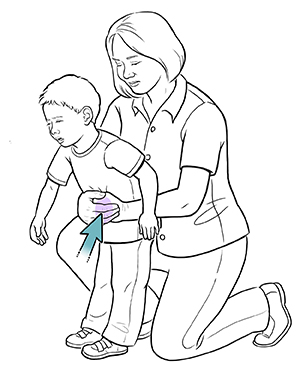When a Child Is Choking (Age 1 and Up)
Young children often want to put things into their mouth. This includes toys and food. And it can include anything they find nearby, such as a pen cap or coin. Small objects can choke a child. This happens when the object slips into the child’s airway (trachea). A blocked airway can be very serious, even deadly. Choking can block the flow of air and cut off oxygen to the brain. This can cause permanent brain damage or death.
This sheet can help you prepare for a choking emergency. It will also help you take steps to prevent a child from choking.
What are choking hazards?
Any object small enough to enter a child's airway can block it. This includes:
-
Small food pieces, such as nuts, grapes, beans, popcorn, hotdog pieces, or food that hasn’t been chewed well
-
Small household objects, such as buttons, marbles, coins, balloons, or beads
-
Small toy parts
-
Button batteries, such as those used for watches, cameras, and small electronics
Signs of choking
The signs of choking can include:
-
Violent coughing
-
A high-pitched sound when breathing in
-
Being unable to cough, breathe, cry, or speak
-
Face that turns pale and blue-tinted
-
Clutching at their throat
What to do
The steps to take when a child is choking will vary. The instructions for each situation are below.
If a child has trouble breathing but can talk and has a strong cough:
-
Do NOT put your finger into the child’s mouth to remove the object. Your finger could push the object deeper into the child’s throat.
-
Call 911. This is because the airway can become fully blocked.
-
Encourage the child to cough until the object comes out. Don't do the Heimlich maneuver. The child's cough is better than the Heimlich maneuver.
-
Watch the child closely to make sure the object comes out and doesn’t shift to fully block the throat.
If a child has trouble breathing but can’t talk or make sounds and is conscious:
-
Do NOT put your finger into the child’s mouth to remove the object. Your finger could push the object deeper into the child’s throat.
-
Tell someone nearby to call 911.
-
Do abdominal thrusts. First, stand or kneel behind the child and wrap your arms around their waist.
-
Make a fist with one hand. Place the thumb-side of your fist into the child's belly just above the bellybutton (navel).
-
Use fast, short motions to thrust inward and upward. Don’t lift the child off the floor while doing this.
-
Continue abdominal thrusts until the object comes out, the child can cough and breathe, the child becomes unconscious, or help arrives.
How to do abdominal thrusts on a conscious child

-
Stand or kneel behind the child and wrap your arms around their waist.
-
Make a fist with one hand.
-
Place the thumb-side of your fist into the child’s belly just above the bellybutton (navel).
-
Grasp your fist with your other hand.
-
Use fast, short motions to thrust inward and upward, giving 5 quick abdominal thrusts. Don’t lift the child off the floor while doing this.
-
Continue abdominal thrusts until the object is dislodged, the child can cough and breathe, the child becomes unconscious, or help arrives.
If a child stops breathing or becomes unconscious:
-
Shout for help and call 911.
-
Lay the child down on their back on a hard, flat surface such as a table, floor, or the ground.
-
Start CPR. Use the heel of your hand to push down on the lower part of the child’s breast bone, just below the nipple line. Press down to at least 1/3 depth of the child's chest, or about 2 inches. You can use 2 hands if you need to. Do this 30 times really fast. This should take about 20 seconds. This is a rate of at least 100 to 120 compressions per minute.
-
Look in the child's mouth for the object before you give 2 rescue breaths. Gently lift the child's chin up with one hand and tilt the head back. Place your mouth over their mouth, pinch the nose shut, and puff 2 breaths into the child's mouth. Each breath should last 1 second. Watch to see if the child's chest rises.
-
If the chest does not rise, give 30 chest compressions. Look in the child's mouth for an object. Remove the object, being careful not to push it back into the throat. If you can't see an object, don't put your finger in the child's mouth.
-
If the child does not start breathing, continue cycles of 30 chest compressions followed by 2 quick breaths. Do this until breathing starts, help arrives, you become too exhausted to continue, or the scene becomes unsafe.
Help prevent a child from choking
-
Keep an eye on children as they eat or play.
-
Keep problem foods and objects away from young children. This includes small foods and small household objects.
-
Don’t let young children play with toys with small parts.
-
Safety-proof your home by removing small objects that a child may reach.
-
Check for toys recalled for choking hazards on the Consumer Product Safety Commission website, www.cpsc.gov .